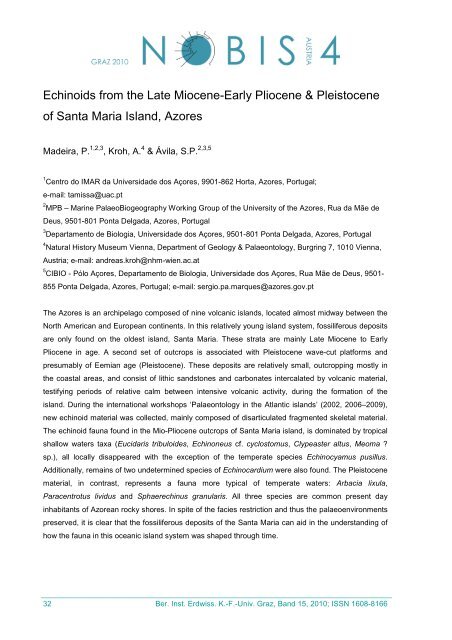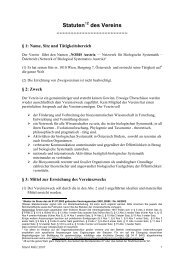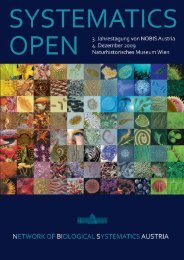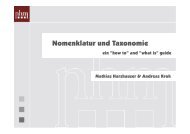4. Jahrestagung von NOBIS Austria 2. - 3. Dezember 2010
4. Jahrestagung von NOBIS Austria 2. - 3. Dezember 2010
4. Jahrestagung von NOBIS Austria 2. - 3. Dezember 2010
You also want an ePaper? Increase the reach of your titles
YUMPU automatically turns print PDFs into web optimized ePapers that Google loves.
Echinoids from the Late Miocene-Early Pliocene & Pleistocene<br />
of Santa Maria Island, Azores<br />
Madeira, P. 1,2,3 , Kroh, A. 4 & Ávila, S.P. 2,3,5<br />
1 Centro do IMAR da Universidade dos Açores, 9901-862 Horta, Azores, Portugal;<br />
e-mail: tamissa@uac.pt<br />
2 MPB – Marine PalaeoBiogeography Working Group of the University of the Azores, Rua da Mãe de<br />
Deus, 9501-801 Ponta Delgada, Azores, Portugal<br />
3 Departamento de Biologia, Universidade dos Açores, 9501-801 Ponta Delgada, Azores, Portugal<br />
4 Natural History Museum Vienna, Department of Geology & Palaeontology, Burgring 7, 1010 Vienna,<br />
<strong>Austria</strong>; e-mail: andreas.kroh@nhm-wien.ac.at<br />
5 CIBIO - Pólo Açores, Departamento de Biologia, Universidade dos Açores, Rua Mãe de Deus, 9501-<br />
855 Ponta Delgada, Azores, Portugal; e-mail: sergio.pa.marques@azores.gov.pt<br />
The Azores is an archipelago composed of nine volcanic islands, located almost midway between the<br />
North American and European continents. In this relatively young island system, fossiliferous deposits<br />
are only found on the oldest island, Santa Maria. These strata are mainly Late Miocene to Early<br />
Pliocene in age. A second set of outcrops is associated with Pleistocene wave-cut platforms and<br />
presumably of Eemian age (Pleistocene). These deposits are relatively small, outcropping mostly in<br />
the coastal areas, and consist of lithic sandstones and carbonates intercalated by volcanic material,<br />
testifying periods of relative calm between intensive volcanic activity, during the formation of the<br />
island. During the international workshops ‘Palaeontology in the Atlantic islands’ (2002, 2006–2009),<br />
new echinoid material was collected, mainly composed of disarticulated fragmented skeletal material.<br />
The echinoid fauna found in the Mio-Pliocene outcrops of Santa Maria island, is dominated by tropical<br />
shallow waters taxa (Eucidaris tribuloides, Echinoneus cf. cyclostomus, Clypeaster altus, Meoma ?<br />
sp.), all locally disappeared with the exception of the temperate species Echinocyamus pusillus.<br />
Additionally, remains of two undetermined species of Echinocardium were also found. The Pleistocene<br />
material, in contrast, represents a fauna more typical of temperate waters: Arbacia lixula,<br />
Paracentrotus lividus and Sphaerechinus granularis. All three species are common present day<br />
inhabitants of Azorean rocky shores. In spite of the facies restriction and thus the palaeoenvironments<br />
preserved, it is clear that the fossiliferous deposits of the Santa Maria can aid in the understanding of<br />
how the fauna in this oceanic island system was shaped through time.<br />
_____________________________________________________________________________<br />
32 Ber. Inst. Erdwiss. K.-F.-Univ. Graz, Band 15, <strong>2010</strong>; ISSN 1608-8166






